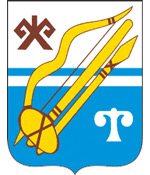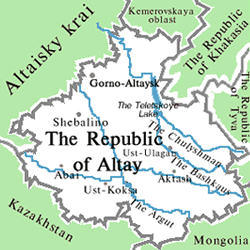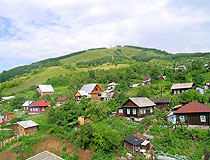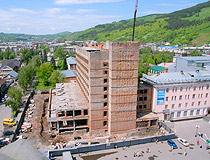History of Gorno-Altaysk
People began to settle in the intermountain basin with a mild microclimate, the territory of the present Gorno-Altaysk, in ancient times. This is evidenced by materials from archaeological sites located within the city limits. The oldest archaeological monument is the Ulalinskaya site - an early Paleolithic complex on the Ulalushka River. The age of this complex is in the range of 300 thousand - 1.5 million years.
The history of the present city dates back to the beginning of the 19th century. The historical name of the settlement is Ulala. In the 1820s, a permanent settlement at the mouth of the Ulalushka River already existed. It was located not far from the Chuysky tract - the road leading from Russia to Mongolia and China.
From 1834 to 1879, the village of Ulala (Ulalinskoye) was the center of the Altai Spiritual Mission involved in the Christianization of the peoples of Altai. In 1838, the first missionary school was opened in the village. The population of Ulala consisted mainly of newly baptized Altaians (also known as Oirats). After a few decades, Ulala became an important center of trade of the Tomsk Governorate.
In the second half of the 19th century, merchants interested in trade with China and Mongolia appeared in Ulala: stone buildings, shops,and a trading square were built. The main occupations of the local residents were agriculture and cattle breeding, as well as crafts: blacksmithing, icon painting, pottery, and others. There were 27 craft workshops in the village.
More historical facts…
At the beginning of the 20th century, Ulala was further developed thanks to the expansion of trade relations with Chinese and Mongolian merchants. By 1910, the village had a rural hospital and a post office, 3 churches, 2 schools. Its population was 3,127 people. The population was mixed, a lot of Russians, but there were also representatives of the indigenous Altai tribes. Ulala became a major cultural and commercial center.
In 1922, an autonomous region (oblast) of the Oirat peoples was formed in Altai, and the village of Ulala was chosen as its center. Active construction began here: the House of Soviets, a bank, shops, “Lenin House”, a movie theater, schools, and a regional hospital. The following educational institutions were opened: a pedagogical technical school, a veterinarian technical school, a planning-economic technical school, and a feldsher-obstetric school.
In 1926, the population of the village was 5,691 people. In 1927, the Oirat Regional Museum of Local Lore with unique collections on the history, culture, and ethnography of the mountain Altai region was opened in Ulala. On February 27, 1928, the village was transformed into a town. In 1932, it was renamed Oirat-Tura (the town of the Oirats). In 1933, its population was 11,763, in 1939 - 24,045.
During the Second World War, the Moscow Pedagogical Institute named after K. Liebknecht, the Tambov Fruit and Vegetable Institute named after Michurin, the Leningrad Flight School, and other institutions were evacuated to Oirat-Tura. Local industrial enterprises switched to the production of military products: military uniforms, skis, sledges, felt boots, etc.
In 1948, Oirat Autonomous Oblast was renamed Gorno-Altai (literally meaning “mountain Altai”) Autonomous Oblast and the town of Oirat-Tura received a new name - Gorno-Altaysk.
In the 1950s-1960s, several factories were opened in Gorno-Altaysk: weaving, sewing, furniture factories, and a reinforced concrete products plant. In the 1970-1980s, the construction industry was actively developing, the construction of multi-apartment residential buildings was carried out. Gorno-Altaysk acquired its present look. In 1989, the population of the city was 46,436 people.
In 1992, the city of Gorno-Altaysk became the capital of the Altai Republic. In 1996, its coat of arms was adopted. In recognition of the significance of the discovery of the Ulalinskaya Paleolithic site, images of ancient tools were placed on the coat of arms of Gorno-Altaysk.
In November 2011, after a long reconstruction, the Gorno-Altaysk airport was opened, which made the city more accessible for tourists.
Gorno-Altaysk from above
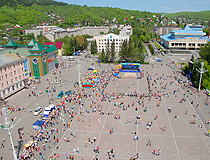
Lenina Square - the central square of Gorno-Altaysk
Author: Alexander Tyryshkin
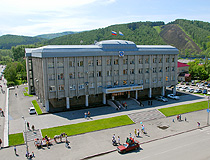
The State Assembly of the Altai Republic in Gorno-Altaysk
Author: Alexander Tyryshkin
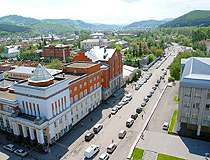
Gorno-Altaysk is a green city
Author: Alexander Tyryshkin
Gorno-Altaysk - Features
Gorno-Altaysk is located in the northwestern part of the Altai Mountains, in the intermontane basin, surrounded by low peaks at an altitude of 270-305 meters above sea level, at the confluence of the Ulalushka and Maima rivers, about 250 kilometers north of Belukha Mountain (4,506 meters), the highest point of Altai and Siberia.
The distance from Gorno-Altaysk to Moscow is about 3,800 km, to the nearest railway station Biysk of the West Siberian Railway - 108 km. Buses are the main passenger transport in the city. The airport of Gorno-Altaysk provides regular flights to Moscow, Yekaterinburg, Novosibirsk.
The climate is sharply continental with hot summers and cold winters with thaws. The average temperature in January is minus 13.7 degrees Celsius, in July - plus 18.9 degrees Celsius. For many years Gorno-Altaysk has been the greenest city in Russia, ranking first in Russian environmental contests and ratings.
Almost all plants built in the Soviet period stopped working after the transition to a market economy. Today, tourism is one of the priorities in the development of the city’s economy (hotels, restaurants, recreation centers, consumer services, trade facilities, production of souvenirs and tourist equipment). In total, Gorno-Altaysk has several dozen hotels and enterprises in the field of tourism.
Here are some places where you can buy interesting souvenirs.
The center of folk crafts “Enchi” has products made of cedar and cedar wood chips (talismans, charms, original souvenirs, and interior items created in the traditions of the ancient Altai culture), national jewelry made of stone, wood, and leather, paintings by local artists. Here you can learn more about the decorative and applied arts, life and national clothes of indigenous people of the Altai Mountains. You can also try on national clothes and take photos. Grigoriya Choros-Gurkina Street, 38.
“Masters of Altai” - a network of souvenir shops located throughout the city. Here you can find a lot of wood products (caskets, dishes, massagers), original birch bark magnets, fur amulets with natural stones, figures of marble chips. Kommunisticheskiy Avenue, 60 (the shopping center “Real”), Kommunisticheskiy Avenue, 16 (the National Drama Theater of the Altai Republic), Chaptynova Street, 24 (the Government of the Altai Republic), Palkina Street, 1 (the State Assembly of the Altai Republic).
Main Attractions of Gorno-Altaysk
The Republican Museum of Local Lore. Opened in 1918, it is the oldest cultural institution in the Republic of Altai. This museum has unique collections of objects of history and culture of the peoples of Altai, collections of clothing and household items, works of fine and decorative art, archaeological materials from excavations of the burial mounds of Ak-Alakh from the Ukok plateau.
Also there are interesting collections of rock samples, finds from the Paleolithic site of ancient people, tools of the Stone Age, as well as collections devoted to ethnography of the Altai people and the Russian Old Believers. The museum has the largest collection of paintings and graphic works by the first Altai artist Grigoriy Choros-Gurkin, as well as works by contemporary artists of the mountainous Altai. Grigoriya Choros-Gurkina Street, 46.
The Altai National Drama Theater - one of the main cultural attractions of Gorno-Altaysk, which is the stage for the performance of Altai creative groups and the venue for a lot of cultural events and exhibitions. Since actors of Russian and Altai nationality play in this theater, performances are staged in two languages - in Russian and Altai. Kommunisticheskiy Avenue, 16.
Ulalinskaya Paleolithic Site - a protected natural site located in the eastern part of Gorno-Altaysk, on the banks of the Ulalushka River. In 1961, a scientific expedition led by archaeologist Alexei Pavlovich Okladnikov discovered traces of the presence of primitive people of the Paleolithic era here. Today, on the site of the Paleolithic site, there is a museum, where you can see an ancient dwelling, household items, weapons, clothing, and tools. Sovetskaya street.
Museum “Altai Stones” in the village of Mayma (Lenina Street, 6), north of Gorno-Altaysk. It is the only specialized geological museum in the Republic of Altai. The expositions of this museum present a wide variety of rocks, minerals, ores, prints of ancient plants, and petrified remains of fossil animals. Almost all artifacts were found in the Altai Mountains. The museum has 14 thematic showcases with specially selected samples of minerals and rocks.
Church of Macarius the Monk of Altai. The construction of this wooden church in honor of all Russian missionaries who had preached in Altai began in 2004. Two years later, the building, built in a style that imitates wooden Russian architecture, was consecrated. Kommunisticheskiy Avenue, 146.
Mount Tugaya. This mountain is located within the city limits, in the north. Here, at an altitude of 641 meters, there is a ski complex where you can go snowboarding and skiing from November to February. There are three slopes up to 1,500 m long with elevation differences of 350 m. Also there is an observation deck at the top of the mountain.
The famous Chuysky Trakt (Chuya Highway) belongs to the historic sights of Gorno-Altaysk. It was used by numerous scientists, researchers, and travelers since ancient times. This highway, crossing the entire Altai Mountains, passes in amazingly beautiful places and is one of the most beautiful roads in Russia.
The unique nature of Altai Mountains, dense forests and clear lakes, diverse mountain landscapes amazing in their magnificence leave an unforgettable impression and, undoubtedly, are also a unique attraction of Gorno-Altaysk and the Republic of Altai.


